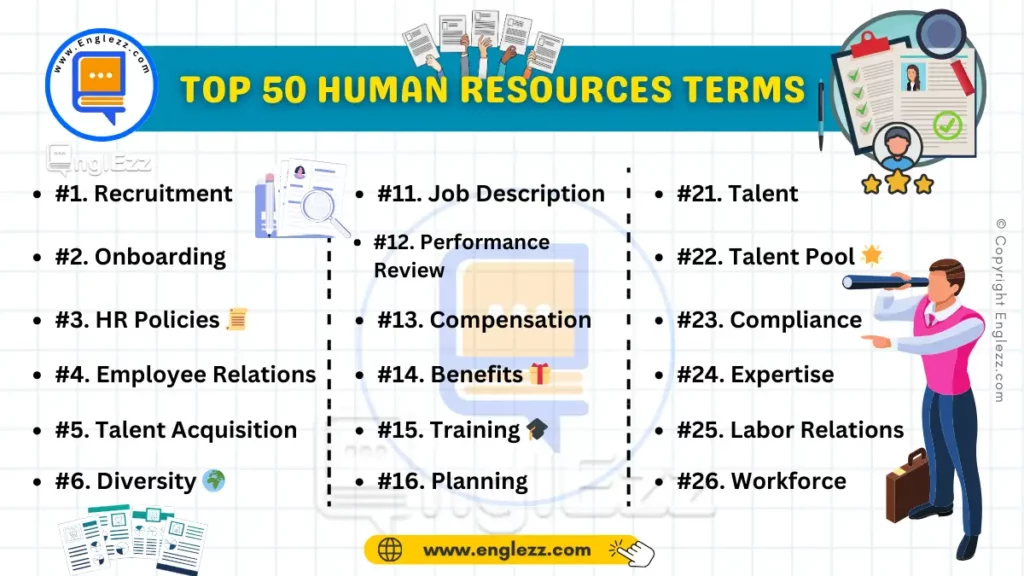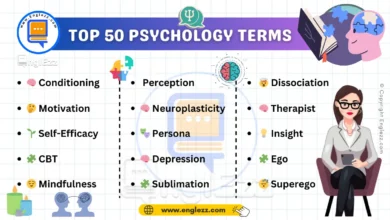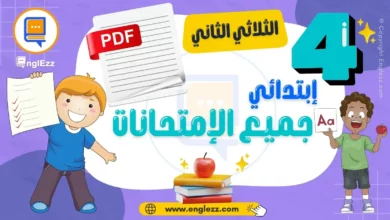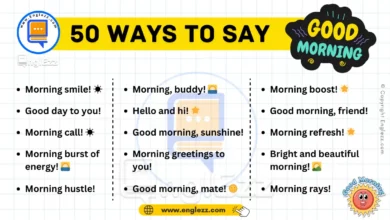In the realm of Human Resources (HR), mastering the language of the field is essential for both students and professionals alike. Understanding HR terminology not only enhances your ability to communicate effectively but also prepares you for the diverse challenges of the workplace. This blog post covers 50 key Human Resources English terms that every student should be familiar with.
Table of Contents
- Top 50 Human Resources Terms for Students: Definitions & Examples
- #1. Recruitment 📋
- #2. Onboarding 🚀
- #3. Performance Appraisal 📊
- #4. Benefits Administration 💼
- #5. Talent Management 🎯
- #6. Compensation Package 💵
- #7. Employee Engagement 📈
- #8. Workforce Planning 🗂️
- #9. Job Description 📝
- #10. Employee Relations 🤝
- #11. Talent Acquisition 🔍
- #12. HR Policies 📚
- #13. Diversity and Inclusion 🌍
- #14. Employee Turnover 🔄
- #15. Workforce Diversity 🎨
- #16. Organizational Culture 🏢
- #17. Human Capital Management 💼
- #18. Succession Planning 📅
- #19. HR Metrics 📊
- #20. Job Satisfaction 😊
- #21. Learning and Development 📚
- #22. Employee Handbook 📖
- #23. Talent Pool 🌟
- #24. Compliance 🏛️
- #25. Workplace Wellness 🧘♂️
- #26. Labor Relations ⚖️
- #27. Workforce Analytics 📊
- #28. Employee Recognition 🌟
- #29. Recruitment Strategy 🧩
- #30. Employee Development 🌱
- #31. Job Rotation 🔄
- #32. Performance Management 📈
- #33. Conflict Resolution 🛠️
- #34. Workforce Engagement 📈
- #35. HR Software 💻
- #36. Employee Benefits Package 🎁
- #37. Human Resources Information System (HRIS) 🖥️
- #38. Organizational Development 📈
- #39. Job Analysis 🔍
- #40. Labor Market Analysis 📊
- #41. Employee Assistance Program (EAP) 🤝
- #42. Talent Retention 🌟
- #43. Labor Union 📜
- #44. Employment Law ⚖️
- #45. Employee Feedback 💬
- #46. Human Resource Development (HRD) 🎓
- #47. Job Enrichment 🌟
- #48. Human Resource Management (HRM) 🧑💼
- #49. Employee Surveys 📊
- #50. Workforce Flexibility 🔄
- Human Resources English Terms Table
- Conclusion
Top 50 Human Resources Terms for Students: Definitions & Examples
Each term is accompanied by a definition, phonetic transcription, and practical examples to illustrate its use. Whether you’re preparing for exams, interviews, or entering the HR profession, this comprehensive guide will equip you with the knowledge needed to excel.
Dive into these essential HR terms and expand your vocabulary to stay ahead in the dynamic world of human resources.
#1. Recruitment 📋
Definition: The process of finding and hiring the best-qualified candidate for a job opening.
Phonetic Transcription: /rɪˈkruːtmənt/
Examples:
- The company’s recruitment strategy focuses on attracting top talent from industry conferences.
- Effective recruitment involves creating detailed job descriptions and utilizing various job boards.
#2. Onboarding 🚀
Definition: The process of integrating a new employee into an organization.
Phonetic Transcription: /ˌɔːnˈbɔːrdɪŋ/
Examples:
- Onboarding includes orientation sessions and providing new hires with the necessary tools.
- A well-structured onboarding program can improve employee retention rates.
#3. Performance Appraisal 📊
Definition: A regular review of an employee’s job performance and overall contribution to the company.
Phonetic Transcription: /pəˈfɔːrməns əˈpreɪzl/
Examples:
- Performance appraisals are typically conducted annually and involve setting goals for future performance.
- Feedback from performance appraisals helps employees identify areas for improvement.
#4. Benefits Administration 💼
Definition: The management of employee benefits such as health insurance, retirement plans, and paid time off.
Phonetic Transcription: /ˈbɛnɪfɪts ˌædmɪnɪˈstreɪʃən/
Examples:
- Benefits administration involves ensuring compliance with legal regulations and managing benefits enrollments.
- HR specialists handle employee inquiries related to their benefits packages.
#5. Talent Management 🎯
Definition: A strategic approach to managing and developing employees to meet organizational goals.
Phonetic Transcription: /ˈtælənt ˈmænɪdʒmənt/
Examples:
- Talent management includes succession planning and career development initiatives.
- Effective talent management helps retain skilled employees and prepare them for future leadership roles.
#6. Compensation Package 💵
Definition: The total value of an employee’s salary and benefits.
Phonetic Transcription: /ˌkɒmpənˈseɪʃən ˈpækɪdʒ/
Examples:
- A compensation package may include bonuses, health insurance, and stock options.
- HR professionals design competitive compensation packages to attract top talent.
#7. Employee Engagement 📈
Definition: The level of an employee’s emotional investment and commitment to their job and organization.
Phonetic Transcription: /ɪmˈplɔɪiː ˌɪnˈɡeɪdʒmənt/
Examples:
- Strategies to boost employee engagement include team-building activities and regular feedback sessions.
- High employee engagement is often linked to increased productivity and job satisfaction.
#8. Workforce Planning 🗂️
Definition: The process of ensuring that an organization has the right number of employees with the right skills at the right time.
Phonetic Transcription: /ˈwɜːrkfɔːrs ˈplænɪŋ/
Examples:
- Workforce planning involves forecasting future hiring needs and developing succession plans.
- Effective workforce planning helps companies manage labor costs and respond to market changes.
#9. Job Description 📝
Definition: A detailed outline of the responsibilities, qualifications, and skills required for a particular role.
Phonetic Transcription: /dʒɒb dɪsˈkrɪpʃən/
Examples:
- Job descriptions are used to attract suitable candidates by clearly defining role expectations.
- Updating job descriptions regularly ensures they reflect the current duties and qualifications.
#10. Employee Relations 🤝
Definition: The management of relationships between employees and the organization to foster a positive working environment.
Phonetic Transcription: /ɪmˈplɔɪiː rɪˈleɪʃənz/
Examples:
- Employee relations involves addressing workplace conflicts and handling grievances.
- Building strong employee relations contributes to a healthy workplace culture.

#11. Talent Acquisition 🔍
Definition: The process of identifying and attracting skilled individuals to fill job openings.
Phonetic Transcription: /ˈtælənt ˌækwɪˈzɪʃən/
Examples:
- Talent acquisition strategies may include recruiting through social media and attending job fairs.
- Effective talent acquisition helps organizations build a strong talent pipeline.
#12. HR Policies 📚
Definition: The guidelines and rules established by an organization to govern employee behavior and company operations.
Phonetic Transcription: /eɪtʃ ɑːr ˈpɒlɪsiz/
Examples:
- HR policies cover various aspects such as attendance, dress code, and disciplinary actions.
- Updating HR policies ensures compliance with current laws and best practices.
#13. Diversity and Inclusion 🌍
Definition: Efforts to create a workplace that respects and values diverse backgrounds and perspectives.
Phonetic Transcription: /daɪˈvɜːsɪti ənd ɪnˈkluːʒən/
Examples:
- Diversity and inclusion initiatives may include training programs and mentorship opportunities.
- Promoting diversity and inclusion enhances creativity and innovation within the workplace.
#14. Employee Turnover 🔄
Definition: The rate at which employees leave an organization and are replaced by new hires.
Phonetic Transcription: /ɪmˈplɔɪiː ˈtɜːrnəʊvər/
Examples:
- High employee turnover can indicate issues with job satisfaction or management practices.
- Reducing turnover involves improving work conditions and providing career development opportunities.
#15. Workforce Diversity 🎨
Definition: The presence of employees from various backgrounds, including race, gender, and age.
Phonetic Transcription: /ˈwɜːrkfɔːrs daɪˈvɜːsɪti/
Examples:
- Workforce diversity initiatives may include recruiting from diverse talent pools and fostering an inclusive culture.
- A diverse workforce can lead to better decision-making and a broader range of perspectives.
#16. Organizational Culture 🏢
Definition: The values, beliefs, and behaviors that shape how employees interact and work together.
Phonetic Transcription: /ˌɔːrɡənaɪˈzeɪʃənl ˈkʌltʃər/
Examples:
- Organizational culture is often reflected in company policies and employee interactions.
- A positive organizational culture can enhance employee satisfaction and productivity.
#17. Human Capital Management 💼
Definition: The strategic approach to managing an organization’s workforce to achieve business objectives.
Phonetic Transcription: /ˈhjuːmən ˈkæpɪtl ˈmænɪdʒmənt/
Examples:
- Human capital management involves training and developing employees to maximize their potential.
- Investing in human capital management leads to better business performance and employee retention.
#18. Succession Planning 📅
Definition: The process of identifying and developing internal personnel to fill key positions within the organization.
Phonetic Transcription: /səkˈsɛʃən ˈplænɪŋ/
Examples:
- Succession planning ensures that there are qualified candidates ready to step into leadership roles.
- Effective succession planning involves mentoring and professional development programs.
#19. HR Metrics 📊
Definition: Quantitative measures used to evaluate HR performance and the impact of HR initiatives.
Phonetic Transcription: /eɪtʃ ɑːr ˈmɛtrɪks/
Examples:
- HR metrics may include employee turnover rates, recruitment costs, and training effectiveness.
- Analyzing HR metrics helps organizations make data-driven decisions and improve HR practices.
#20. Job Satisfaction 😊
Definition: The level of contentment an employee feels towards their job and work environment.
Phonetic Transcription: /dʒɒb ˌsætɪsˈfækʃən/
Examples:
- Job satisfaction can be influenced by factors such as work-life balance, compensation, and recognition.
- Surveys are often used to measure job satisfaction and identify areas for improvement.
#21. Learning and Development 📚
Definition: The process of enhancing employees’ skills and knowledge to improve their performance and career growth.
Phonetic Transcription: /ˈlɜːrnɪŋ ənd dɪˈvɛləpmənt/
Examples:
- Learning and development programs may include workshops, seminars
, and online courses.
- Investing in learning and development helps employees stay updated with industry trends and advance their careers.
#22. Employee Handbook 📖
Definition: A document that outlines the company’s policies, procedures, and expectations for employees.
Phonetic Transcription: /ɪmˈplɔɪiː ˈhændbʊk/
Examples:
- An employee handbook provides information on company rules, benefits, and disciplinary procedures.
- Regular updates to the employee handbook ensure it reflects current laws and company practices.
#23. Talent Pool 🌟
Definition: A database or network of potential job candidates with the skills and qualifications required by an organization.
Phonetic Transcription: /ˈtælənt puːl/
Examples:
- Building a talent pool involves networking and maintaining relationships with potential candidates.
- A strong talent pool helps organizations quickly fill job openings with qualified individuals.
#24. Compliance 🏛️
Definition: Adhering to laws, regulations, and company policies related to employment and workplace practices.
Phonetic Transcription: /kəmˈplaɪəns/
Examples:
- HR professionals ensure compliance with labor laws and health and safety regulations.
- Regular audits and training help maintain compliance and avoid legal issues.
#25. Workplace Wellness 🧘♂️
Definition: Programs and initiatives aimed at improving employees’ physical and mental health.
Phonetic Transcription: /ˈwɜːrkpleɪs ˈwɛlnəs/
Examples:
- Workplace wellness programs may include fitness classes, mental health resources, and healthy eating initiatives.
- Promoting workplace wellness can lead to increased employee satisfaction and reduced absenteeism.
#26. Labor Relations ⚖️
Definition: The interaction between employers and employees, often involving negotiations and dispute resolution.
Phonetic Transcription: /ˈleɪbər rɪˈleɪʃənz/
Examples:
- Labor relations may involve bargaining with labor unions and addressing employee grievances.
- Effective labor relations strategies help maintain a positive and productive work environment.
#27. Workforce Analytics 📊
Definition: The use of data and statistical analysis to manage and optimize workforce performance.
Phonetic Transcription: /ˈwɜːrkfɔːrs əˈnælɪtɪks/
Examples:
- Workforce analytics can provide insights into employee productivity, turnover rates, and hiring trends.
- Utilizing workforce analytics helps organizations make informed HR decisions and improve operational efficiency.
#28. Employee Recognition 🌟
Definition: Acknowledging and rewarding employees for their contributions and achievements.
Phonetic Transcription: /ɪmˈplɔɪiː ˌrɛkˈnɪʃən/
Examples:
- Employee recognition programs may include awards, bonuses, and public acknowledgments.
- Recognizing employees’ efforts boosts morale and encourages continued high performance.
#29. Recruitment Strategy 🧩
Definition: A plan for attracting, selecting, and hiring the best candidates for job vacancies.
Phonetic Transcription: /rɪˈkruːtmənt ˈstrætədʒi/
Examples:
- A recruitment strategy may involve using social media, employee referrals, and targeted job ads.
- Developing a recruitment strategy helps organizations efficiently fill positions and reduce hiring costs.
#30. Employee Development 🌱
Definition: The ongoing process of improving employees’ skills and knowledge to advance their careers and performance.
Phonetic Transcription: /ɪmˈplɔɪiː dɪˈvɛləpmənt/
Examples:
- Employee development programs may include mentorship, training workshops, and career planning.
- Investing in employee development enhances job satisfaction and supports career progression.
#31. Job Rotation 🔄
Definition: A practice where employees are moved between different jobs or roles within an organization.
Phonetic Transcription: /dʒɒb roʊˈteɪʃən/
Examples:
- Job rotation helps employees gain a broader understanding of the organization and develop new skills.
- Implementing job rotation can increase employee engagement and reduce job monotony.
#32. Performance Management 📈
Definition: The ongoing process of setting goals, assessing performance, and providing feedback to employees.
Phonetic Transcription: /pəˈfɔːrməns ˈmænɪdʒmənt/
Examples:
- Performance management involves regular check-ins, performance reviews, and goal-setting meetings.
- Effective performance management helps align employee objectives with organizational goals.
#33. Conflict Resolution 🛠️
Definition: The process of addressing and resolving disagreements or disputes between individuals or groups.
Phonetic Transcription: /ˈkɒnflɪkt ˌrɛzəˈluːʃən/
Examples:
- Conflict resolution techniques include mediation, negotiation, and arbitration.
- Developing conflict resolution skills helps maintain a harmonious and productive workplace.
#34. Workforce Engagement 📈
Definition: The level of enthusiasm and commitment employees have towards their work and organization.
Phonetic Transcription: /ˈwɜːrkfɔːrs ɪnˈɡeɪdʒmənt/
Examples:
- Strategies to enhance workforce engagement include recognizing achievements and offering professional growth opportunities.
- High workforce engagement leads to increased productivity and reduced turnover rates.
#35. HR Software 💻
Definition: Technology solutions used to manage various HR functions such as payroll, recruitment, and employee records.
Phonetic Transcription: /eɪtʃ ɑːr ˈsɒftwɛə(r)/
Examples:
- HR software systems can automate tasks like leave management and performance tracking.
- Implementing HR software improves efficiency and accuracy in managing HR processes.
#36. Employee Benefits Package 🎁
Definition: A collection of benefits offered to employees, including health insurance, retirement plans, and other perks.
Phonetic Transcription: /ɪmˈplɔɪiː ˈbɛnɪfɪts ˈpækɪdʒ/
Examples:
- An employee benefits package may also include tuition reimbursement and wellness programs.
- Offering a competitive benefits package helps attract and retain top talent.
#37. Human Resources Information System (HRIS) 🖥️
Definition: A software application that manages HR functions such as employee data, payroll, and benefits administration.
Phonetic Transcription: /ˈhjuːmən ˈrɒsɔːrzɪz ˌɪnfəˈmeɪʃən ˈsɪstəm/
Examples:
- HRIS systems streamline HR tasks and improve data accuracy.
- Implementing an HRIS can reduce administrative overhead and enhance reporting capabilities.
#38. Organizational Development 📈
Definition: The practice of improving an organization’s effectiveness and health through planned change efforts.
Phonetic Transcription: /ˌɔːrɡənaɪˈzeɪʃənl dɪˈvɛləpmənt/
Examples:
- Organizational development initiatives may include leadership training and process improvements.
- Effective organizational development helps align strategies with business goals and foster growth.
#39. Job Analysis 🔍
Definition: The process of gathering, analyzing, and documenting information about a job’s requirements and responsibilities.
Phonetic Transcription: /dʒɒb əˈnælɪsɪs/
Examples:
- Job analysis helps create accurate job descriptions and identify necessary qualifications.
- Conducting job analysis ensures that recruitment and performance evaluations are based on objective criteria.
#40. Labor Market Analysis 📊
Definition: The examination of labor market trends, including supply and demand for various skills and occupations.
Phonetic Transcription: /ˈleɪbər ˈmɑːrkɪt əˈnælɪsɪs/
Examples:
- Labor market analysis helps HR professionals understand competitive salaries and recruitment challenges.
- Utilizing labor market data supports strategic workforce planning and talent acquisition efforts.
#41. Employee Assistance Program (EAP) 🤝
Definition: A workplace program that provides employees with confidential counseling and support services.
Phonetic Transcription: /ɪmˈplɔɪiː əˈsɪstəns ˈprəʊɡræm/
Examples:
- EAPs offer resources for managing stress, personal issues, and work-related problems.
- Providing access to an EAP enhances employee well-being and supports a positive work environment.
#42. Talent Retention 🌟
Definition: Strategies and practices aimed at keeping valuable employees within the organization.
Phonetic Transcription: /ˈtælənt rɪˈtɛnʃən/
Examples:
- Talent retention efforts may include career development opportunities and competitive compensation.
- High talent retention rates are crucial for maintaining organizational stability and performance.
#43. Labor Union 📜
Definition: An organized group of workers who come together to advocate for their rights and negotiate with employers.
Phonetic Transcription: /ˈleɪbər ˈjuːniən/
Examples:
- Labor unions negotiate collective bargaining agreements and address workplace issues.
- Employees may join a labor union to gain better working conditions and job security.
#44. Employment Law ⚖️
Definition: The body of laws and regulations governing the relationship between employers and employees.
Phonetic Transcription: /ɪmˈplɔɪmənt lɔː/
Examples:
- Employment law covers areas such as workplace safety, discrimination, and wage and hour regulations.
- HR professionals must stay informed about employment law changes to ensure compliance.
#45. Employee Feedback 💬
Definition: Information provided by employees about their experiences, performance, and job satisfaction.
Phonetic Transcription: /ɪmˈplɔɪiː ˈfiːdbæk/
Examples:
- Employee feedback can be collected through surveys, performance reviews, and informal conversations.
- Using employee feedback to make improvements can enhance workplace morale and productivity.
#46. Human Resource Development (HRD) 🎓
Definition: The process of developing employees’ skills, knowledge, and abilities to improve organizational performance.
Phonetic Transcription: /ˈhjuːmən rɪˈsɔːrzɪz dɪˈvɛləpmənt/
Examples:
- HRD initiatives may include training programs, mentorship, and career development planning.
- Investing in HRD supports employee growth and aligns individual goals with organizational objectives.
#47. Job Enrichment 🌟
Definition: Enhancing a job’s content to increase employees’ satisfaction and motivation by adding variety and challenge.
Phonetic Transcription: /dʒɒb ɪnˈrɪʃmənt/
Examples:
- Job enrichment may involve adding new tasks, increasing autonomy, and providing opportunities for skill development.
- Implementing job enrichment strategies can lead to higher employee engagement and reduced turnover.
#48. Human Resource Management (HRM) 🧑💼
Definition: The strategic approach to managing an organization’s workforce to achieve business goals.
Phonetic Transcription: /ˈhjuːmən rɪˈsɔːrzɪz ˈmænɪdʒmənt/
Examples:
- HRM encompasses functions such as recruitment, training, and performance management.
- Effective HRM practices help align employee goals with organizational objectives and improve overall performance.
#49. Employee Surveys 📊
Definition: Tools used to gather employees’ opinions and feedback on various aspects of their work experience.
Phonetic Transcription: /ɪmˈplɔɪiː ˈsɜːrveɪz/
Examples:
- Employee surveys can assess job satisfaction, workplace culture, and areas for improvement.
- Analyzing survey results helps organizations address concerns and enhance employee engagement.
#50. Workforce Flexibility 🔄
Definition: The ability of an organization to adapt its workforce to changing demands and conditions.
Phonetic Transcription: /ˈwɜːrkfɔːrs ˌflɛksɪˈbɪləti/
Examples:
- Workforce flexibility may involve implementing remote work options and adjusting staffing levels.
- A flexible workforce helps organizations respond to market changes and maintain operational efficiency.
Human Resources English Terms Table
| #1. Recruitment 🕵️♂️ | #11. Job Description 📋 | #21. Employee Handbook 📖 |
| #2. Onboarding 🛠️ | #12. Performance Review 📝 | #22. Talent Pool 🌟 |
| #3. HR Policies 📜 | #13. Compensation 💵 | #23. Compliance 🏛️ |
| #4. Employee Relations 🤝 | #14. Benefits 🎁 | #24. Workplace Wellness 🧘♂️ |
| #5. Talent Acquisition 🚀 | #15. Training 🎓 | #25. Labor Relations ⚖️ |
| #6. Diversity 🌍 | #16. Workforce Planning 📅 | #26. Workforce Analytics 📊 |
| #7. Recruitment Strategy 🧩 | #17. Job Rotation 🔄 | #27. Employee Recognition 🌟 |
| #8. Employee Development 🌱 | #18. Conflict Resolution 🛠️ | #28. HR Software 💻 |
| #9. Job Analysis 🔍 | #19. Talent Retention 🌟 | #29. Employee Benefits Package 🎁 |
| #10. Labor Market Analysis 📊 | #20. Labor Union 📜 | #30. Human Resource Management 🧑💼 |
Conclusion
Mastering HR terminology is crucial for students and professionals aiming to navigate the complexities of the human resources field. Understanding these 50 essential Human Resources terms will not only enhance your knowledge but also prepare you for real-world applications in recruitment, employee management, and organizational development.
This comprehensive guide serves as a valuable resource for building your HR vocabulary and staying informed about industry practices.
By familiarizing yourself with these terms, you’ll be better equipped to contribute to effective HR strategies and support organizational success.
Continue to explore and expand your HR expertise to thrive in this dynamic and ever-evolving profession.









Ready to master the essential Human Resources terms?🚀 Discover 50 key HR concepts you need to know and boost your career!
📚Follow and like @EnglEzz for more expert insights and useful tips. Check out the full guide here:
.
https://www.englezz.com/top-50-human-resources-terms/
.
#EnglEzz #Vocabulary #Linguistics #HR #HumanResources #CareerDevelopment #Workplace #EmployeeEngagement #JobSearch